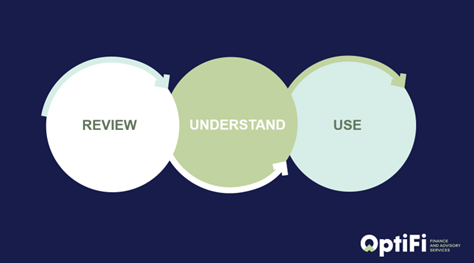Understand – Go Deeper Into the Numbers
Welcome back to our blog series where we’re sharing simple, practical tips to help you build a stronger business.
In our first post, we focused on the importance of Review — checking that you have the right information and regular reports to see how your business is performing.
Now, we move to step two: Understand.
This is where we go beyond simply having reports and start learning what they actually mean.
Finance 101: Getting the Basics Right
Every number in your financial reports tells you something — about your pricing, your customers, your operations, and ultimately, your profitability. Here are a few fundamentals worth understanding well:
Gross Margin (Selling Price – Cost of Goods Sold)
This is a core measure of your business’s financial health. A few key questions to ask yourself:
Have you worked out your true cost per item and added a margin?
Are you:
Reviewing your prices regularly?
Charging enough — and charging all the customers you should be?
Factoring in freight or delivery costs as part of your gross margin?
Updating your selling prices when your costs increase?
A good gross margin means you’re building a business that can cover overheads and deliver profit — not just sales.
Debtors & Creditors Management
Review your aged debtors report monthly. Are you following up on overdue accounts?
Keep an eye on your creditor terms — paying suppliers too fast while waiting on slow customers can choke your cash flow.
Good management here helps protect your working capital and avoid unnecessary stress.
Inventory Management
How much stock are you holding — and is it the right stock?
Consider whether your suppliers can provide Just-in-Time (JIT) delivery to reduce holding costs.
Regularly review slow-moving or obsolete stock.
Well-managed inventory reduces waste and frees up cash.
Sales Analysis & Cost Control
Understanding your sales patterns and cost behaviour gives you insights that drive better decisions:
Sales by category – Which products or services are most profitable?
Gross Profit Margins – Are they consistent across customers and inputs?
Selling price trends – Are you competing on price, value, or both?
Expense Variances – Review budget vs actuals. What’s fixed, what’s variable, and where are the surprises?
Balance Sheet Insights
Your balance sheet can tell you a lot if you know where to look:
Aged debtors – How much are you owed?
Cash balance – Do you have a healthy buffer?
Inventory holdings – Too much, too little, or just right?
Owner’s equity – Are you building long-term value?
What’s Next?
In our next blog, we’ll look at how to Use these insights — translating your numbers into actions that improve performance, reduce risk, and support smart growth.
About the People Behind OptiFi
We’re a team of senior finance professionals, CFOs, and business owners with extensive experience across commercial finance, governance, and small business.
Our passion is helping Kiwi businesses thrive — with clear reporting, practical insights, and tailored support.


